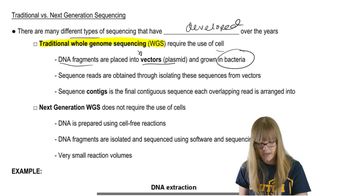Table of contents
- 1. Introduction to Genetics51m
- 2. Mendel's Laws of Inheritance3h 37m
- 3. Extensions to Mendelian Inheritance2h 41m
- 4. Genetic Mapping and Linkage2h 28m
- 5. Genetics of Bacteria and Viruses1h 21m
- 6. Chromosomal Variation1h 48m
- 7. DNA and Chromosome Structure56m
- 8. DNA Replication1h 10m
- 9. Mitosis and Meiosis1h 34m
- 10. Transcription1h 0m
- 11. Translation58m
- 12. Gene Regulation in Prokaryotes1h 19m
- 13. Gene Regulation in Eukaryotes44m
- 14. Genetic Control of Development44m
- 15. Genomes and Genomics1h 50m
- 16. Transposable Elements47m
- 17. Mutation, Repair, and Recombination1h 6m
- 18. Molecular Genetic Tools19m
- 19. Cancer Genetics29m
- 20. Quantitative Genetics1h 26m
- 21. Population Genetics50m
- 22. Evolutionary Genetics29m
15. Genomes and Genomics
Sequencing the Genome
Problem 11
Textbook Question
When comparing genes from two sequenced genomes, how does one determine whether two genes are orthologous? What pitfalls arise when one or both of the genomes are not sequenced?
 Verified step by step guidance
Verified step by step guidance1
span>Step 1: Understand the concept of orthologous genes. Orthologous genes are genes in different species that evolved from a common ancestral gene by speciation. They often retain the same function across species.</span
span>Step 2: Use sequence alignment tools to compare the gene sequences from the two genomes. Tools like BLAST (Basic Local Alignment Search Tool) can help identify similarities between the sequences.</span
span>Step 3: Analyze the phylogenetic context. Construct a phylogenetic tree to see if the genes in question are more closely related to each other than to any other genes in the genomes. This helps confirm orthology.</span
span>Step 4: Consider synteny, which is the conservation of gene order on chromosomes. If the genes are located in similar chromosomal regions across the species, this supports the orthology hypothesis.</span
span>Step 5: Be aware of pitfalls. If one or both genomes are not fully sequenced, there may be missing data, leading to incorrect conclusions. Additionally, gene duplications and losses can complicate the identification of orthologs.</span
 Verified video answer for a similar problem:
Verified video answer for a similar problem:This video solution was recommended by our tutors as helpful for the problem above
Video duration:
2mPlay a video:
Was this helpful?
Key Concepts
Here are the essential concepts you must grasp in order to answer the question correctly.
Orthologous Genes
Orthologous genes are genes in different species that evolved from a common ancestral gene through speciation. They typically retain the same function across species, making them crucial for comparative genomics. Identifying orthologs helps in understanding evolutionary relationships and functional conservation.
Recommended video:
Guided course

Mapping Genes
Genome Sequencing
Genome sequencing is the process of determining the complete DNA sequence of an organism's genome. Accurate sequencing is essential for identifying genes and their relationships. If one or both genomes are not sequenced, it can lead to incomplete data, making it difficult to accurately determine orthology.
Recommended video:
Guided course

Sequencing Difficulties
Pitfalls in Comparative Genomics
Pitfalls in comparative genomics include misidentifying orthologs due to incomplete or erroneous genome data, which can lead to false conclusions about gene function and evolutionary history. Additionally, gene duplication events can complicate ortholog identification, as paralogs (genes related by duplication) may be mistakenly compared instead of true orthologs.
Recommended video:
Guided course

Genomics Overview

 8:55m
8:55mWatch next
Master Sequencing Overview with a bite sized video explanation from Kylia Goodner
Start learning



